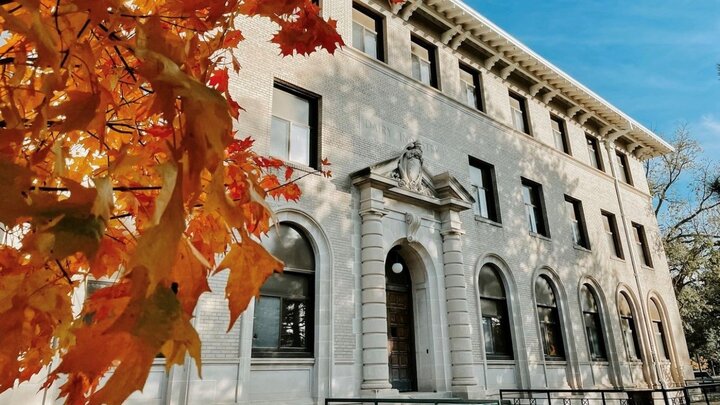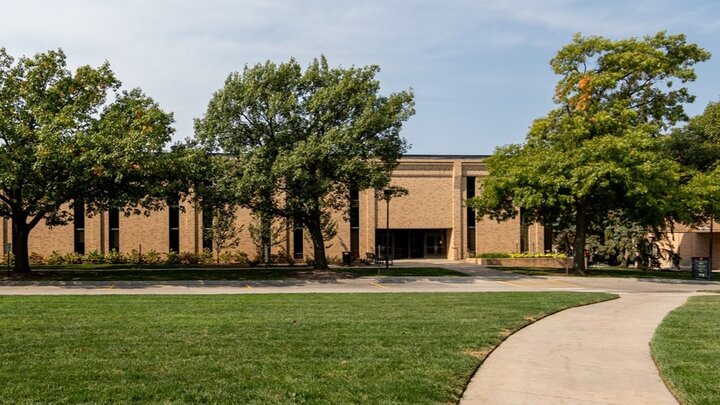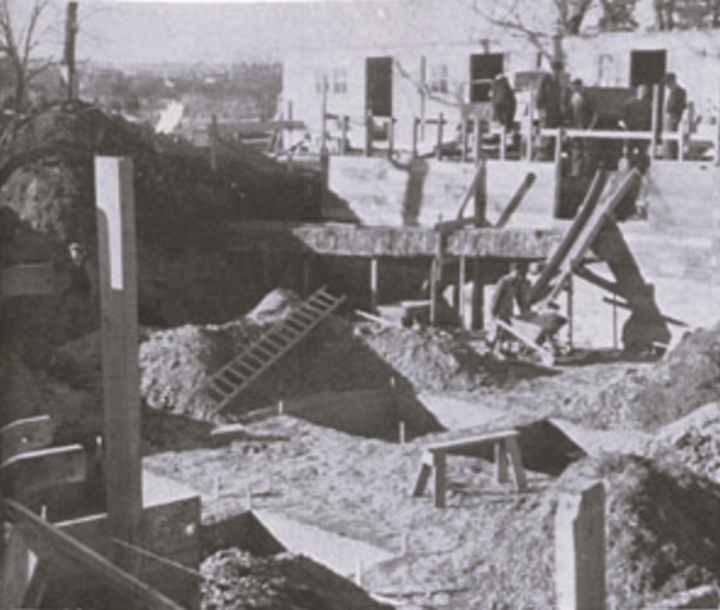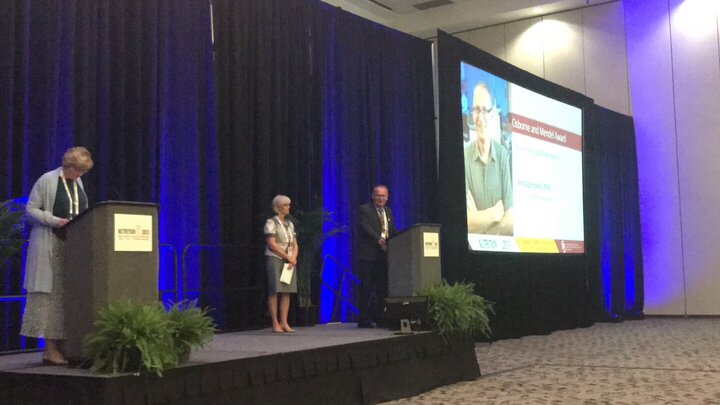Our Mission
To discover and apply scientific information related to food, nutrition, physical activity, and health behavior to optimize public health and well-being.
Our Facilities & Resources
The Department of Nutrition and Health Sciences (NHS) represents the successful integration of the Department of Nutritional Sciences and Dietetics and the Department of Health and Human Performance. By integrating diverse expertise across nutrition, health education, exercise science, and wellness disciplines, NHS offers a comprehensive approach to individual and community health and wellness.
NHS operates across three University of Nebraska locations to serve diverse student populations and research needs throughout the university system:
City Campus | East Campus | Innovation Campus |

Carolyn Pope Edwards Hall | 
Ruth Leverton Hall | 
Scarlet Hotel |

Filley Hall | ||

Gwendolyn Newkirk Human Sciences Building |
Our History
-
1891
The Department of Health and Human Performance was established when the Board of Regents voted to require physical training for female students as a partial equivalent to the military drill required of male students.
Professional preparation of physical education teachers began later in the 1890s.
-
1898

Rosa Bouton (1860-1951) founded the Home Economics Department at the University in 1898. Originally devised as a two-year program in Domestic Science, the program quickly expanded under her guidance.
Housed in Mechanic Arts Hall on city campus, Dr. Bouton also served as the school's sole instructor with eleven newly enrolled students. Domestic Chemistry courses covered subjects such as food analysis, sanitation, and contaminants in food.
As described by the University Bulletin, the two-year program was: "To train the mind and develop character in the kitchen as well as in the laboratory. Special attention is given to the principles of cooking, economical methods of cooking, as well as methods to render food nutrition, palatable, and attractive."

Domestic Science class at Mechanic Arts Hall, 1904 -
1905

The Nebraska Board of Regents elected to construct a new building on the Farm Campus to house laboratories and classrooms needed by the School of Domestic Science. Professor Bouton worked closely with architects Fiske and Dieman to build a specialized facility that included kitchens, living and sleeping rooms, and classrooms.
Originally started as a nutrition course in "domestic chemistry", the program soon became known as the Department of Home Economics and the course of study was expanded to a four-year college degree.
-
1908

Construction of the new Home Economics Building was completed with classes beginning that summer.
Named "The Women's Building" during planning and construction, the upper levels provided dormitory rooms for up to 40 women and included laboratories and classrooms for Home Economics instruction. The main floor included a public cafeteria, as well as labs and additional instructional space.
Initially planned by Ferdinand Fiske and Rosa Bouton as a slightly more elegant building, many high-cost details were converted to less expensive materials. Specifications for maple floors and oak finishing were converted to pine on the upper floors to keep costs down, and a copper cornice was converted to galvanized steel.
-
1909
Home Economics became a department within the College of Agriculture where "...instruction is given for the practical problems of home life. Special attention is given to the artistic, economic, and sociological problems which form a legitimate part of this work.". New courses included clothing construction and design, dietetics, home decoration, household administration, and teacher training with practice teaching.
As the department continued to grow, its course offerings expanded to include child development, education, interior decorating, and research programs. Dormitory rooms were also converted to classes, offices and laboratories.
-
1925

With the University still lacking a suitable facility for basketball, commencement, dances, and other social activities, ground was broken for the new Coliseum. At a cost of $435,000, construction was completed in time for Commencement exercises to be held there in the spring of 1926.
Along with originally housing several offices which included the Men's Athletic Department and Men's Physical Education Department, the Coliseum has also been the site of many important cultural and athletic events held on the University campus. For many years, it served as a much-needed venue for commencement exercises. Well known swing bands regularly played at dances and concerts at the Coliseum, including Glenn Miller, Tommy Dorsey, Les Brown and Harry James. The Coliseum also served as home to the national championship UNL Volleyball team until 2013.
-
1937

After receiving her Ph.D. in Nutrition from the University of Chicago, Dr. Ruth Leverton (a 1932 University of Arizona graduate with a M.S. in Nutrition and a 1928 University of Nebraska graduate with a B.S. in Home Economics) returned to the University of Nebraska to become an assistant professor in the School of Home Economics.
With her hiring, Food and Nutrition quickly began to emerge as a research-based field. During this same period, the Nebraska Agricultural Experimental Station was also seeking an innovative leader to foster human nutrition research on campus and Dr. Leverton was just the person for the job.
Although charged with initiating human nutrition research at UNL, space was limited on the College of Agriculture campus, and she was given a small laboratory in the meat science building.
While Dr. Leverton had both the necessary competencies and resources to conduct valid nutrition research work using human subjects, the development of those resources would prove to be a long struggle. Knowing her own potential, she worked tirelessly with the university and urged them to construct a building specifically to house nutrition laboratories and to accommodate vital nutrition research.
-
1941
Funding was approved by the Board of Regents for the establishment of a new Food and Nutrition building on Ag Campus. Upon appropriating the money, the Legislature stated: "This building was planned to house the cafeteria kitchen, club and private dining rooms, fountain room, and a comfortable lounge together with necessary offices and bathrooms."
Initial stages of the building's excavation began during the Thanksgiving break in November with active construction starting in December.

-
1943
The Board of Regents accepted the Food and Nutrition Building as completed on March 12, 1943. Designed to house more than just food and nutrition laboratories, the building included a cafeteria, dining rooms, a kitchen, offices, classrooms, and research facilities. This window, which was set over the main entrance and is still in place today, features the Betty Lamp, a symbol representing the field of Home Economics:

Like other war era buildings on the University's campuses, and with the nation in the midst of World War II, the Food and Nutrition Building was assumed by the government and appropriated for the war effort shortly after it was constructed. It was initially used as dormitory and classrooms for Specialized Training, Assignment, and Reclassification (STARS) members, a special training branch of the U.S. Government which channeled new military recruits to appropriate education situations. The University of Nebraska was one of only three colleges in the United States designated to assess and assign recruits on to any of 220 higher education sites.
Over the course of two years, more than 13,000 men from the United States, as well as other countries of the world, lived in the Food and Nutrition Building before being reassigned to study engineering, foreign languages, personnel psychology, dentistry, and medicine in the U.S. Army's Specialized Training Program (ASTP).

Army recruits in formation outside of the Food and Nutrition Building, 1943 That fall, the Food and Nutrition Building saw its first "civilian personnel" as occupants moved into the third floor. This location served as the new headquarters for Dr. Leverton's research group and staff.
-
1945
University Chancellor C. S. Boucher and the Board of Regents authorized the furnishing and equipment of a recreation center in the new Food and Nutrition Building. The center was slated to include a general lounge and reading room, a fountain, an all-purpose room for meeting and an annex to the fountain as a dance hall, a record room, two small committee rooms or organization offices, and check stands.
-
1946
Cafeteria and food laboratories became operational within the Food and Nutrition Building.
-
1957
Cafeteria remodeling and reorganization took place at the Food and Nutrition building in order to provide meals for students living in the new residence halls on the College of Agriculture Campus.
-
1968
Construction was completed on the Women's Physical Education Building at 14th and Vine and the building was dedicated that November. It featured two gyms, a swimming pool, dance studio, and locker rooms.
-
1973
After 65 years, the Home Economics building was falling into disrepair, seriously damaged by termites, and no longer offering adequate work quarters.
With Nebraska Legislature appropriating funds for a modern Home Economics building to be constructed on the same site, the decision was made to raze the original Home Economics building.
-
1974
Nebraska Legislature appropriated $700,000 for remodeling/renovation of the Food and Nutrition building. Updates would include offices and specialized laboratories for Teaching, Research, Extension for Human Development and the Family as well as for Food and Nutrition. Facilities would also be added for live-in subjects, dormitory space, and a kitchen/dining area.
-
1975
That January, the Food and Nutrition building was vacated to commence renovation work.
-
1976
By fall, the newly renovated Food and Nutrition building was ready to house both Food and Nutrition faculty as well as the Human Development and Family department.
-
1977

With the opening of the new East Campus Union, space became available within the Food and Nutrition building to offer students laboratory experiences in institution management and quantity food preparation.
The Women's Physical Education Building at 14th and Vine Streets was renovated to add classrooms, computer labs, and offices for instructors.
As a pioneer of physical education, particularly for women in the early part of the twentieth century, Mabel Lee spent the bulk of her professional career at the University of Nebraska-Lincoln. She served as the director of physical education for women as well as a professor from 1924 to 1952.
The Women's Physical Education Building was renamed in her honor on May 7, 1977.
-
1978

As a distinguished scientist and internationally respected author, lecturer, and educator, Dr. Ruth Leverton was a leader in the field of nutrition science and nutrition policy. She possessed an unusual talent for communicating complex scientific facts in clear and usable form. Other scientists, physicians, and dietitians drew on her findings in advising the public on good nutritional habits, helping low-income families maintain adequate diets, and assuring balanced menus in schools and institutions.
She was professionally active and received numerous awards, including a Fulbright Scholar Award that took her to the Philippines. She traveled throughout Europe, Asia and Africa promoting proper nutrition through UNESCO and the FAO. Her knowledge of nutritional needs in developing countries was critical to the success of the United States Governments' international food distribution program. Her achievements profoundly affected human welfare and quality of life around the world.
After 17 years with the University of Nebraska, she was hired by the United States Department of Agriculture, Human Nutrition Research Division. in 1957 and over the years, continued to hold increasingly responsible positions with the USDA.
Faculty members within the Department of Food and Nutrition submitted a proposal to rename the Food and Nutrition building in her honor and on May 6, 1978, the building was proudly renamed Ruth Leverton Hall. Dr. Leverton was on-site that day to attend the dedication ceremony as part of UNL's Alumni Day Program.
-
2010
Ruth Leverton Hall was renovated to include updated air handling systems, redesigned building space, and completion of the new Biomedical Research Core (BORC) lab.
-
2020

Spring demolition of Mabel Lee Hall cleared the way for Carolyn Pope Edwards Hall, the College of Education and Human Sciences' new home.
This state-of-the-art facility features modern classrooms, collaborative meeting spaces, faculty offices, research laboratories, and a 400-seat auditorium.
-
2022

Construction of Carolyn Pope Edwards Hall was completed by summer's end. In early September, the Human Performance and Body Composition lab transferred here from its previous location at Neihardt Hall.
-
2025

The Hospitality, Restaurant, Tourism Management program (HRTM) will relocate to the Scarlet Hotel on Innovation Campus during June 2025. This move will provide expanded facilities for the program, featuring new academic spaces, office suites, and a commercial teaching kitchen for hands-on education.
Our Curriculum
-
1919
Curriculum at the University of Nebraska was changed to place more emphasis on professional training such as dietetics, institutional management, and teaching. Also included for the first time were courses intended primarily for graduate students.
-
1921
The Division of Food and Nutrition was established.
-
1962
Approval for a dietetics program was received from the American Dietetic Association.
-
1967
Master's degree program approved.
-
1969
Dietetics internship program initiated.
-
1975
After years of pursuing independent existences, the men's and women's physical education departments merge to form a single Department of Physical Education and Recreation.
-
1977
The Nebraska Center for Health Education, previously affiliated with the University Health Center, was added to the department to form a new School of Health, Physical Education, and Recreation.
-
1991
The department is renamed Nutritional Sciences and Dietetics and serves as one of three departments offered within the Human Resources and Family Sciences Program.
-
1993
The School of Health, Physical Education, and Recreation was renamed Department of Health and Human Performance.
-
1997
Community Nutrition and Health Promotion established as a graduate specialization.
-
2003
The Department of Nutritional Sciences and Dietetics and Department of Health and Human Performance are merged and renamed the Department of Nutrition and Health Sciences.
-
2004
The University of Nebraska-Lincoln Athletic Training Program received initial accreditation from the Commission on Accreditation of Allied Health Education Programs (CAAHEP). (In 2006, accreditation was transferred to the newly formed Commission on the Accreditation of Athletic Training Education [CAATE]).
-
2005
Nutrition and Exercise approved as an undergraduate program.
-
2006
Hospitality, Restaurant, and Tourism Management established as an undergraduate program.
-
2017
Community Health and Wellness approved as an undergraduate program.
-
2019
Biochemical and Molecular Nutrition established as a graduate specialization.
-
2020
Hospitality Management established as a graduate specialization.
-
2021
Professional Studies in Dietetics (PSD) established as a graduate specialization.
-
2023
The Master's in Athletic Training degree was established with the program being nationally accredited by the Commission on the Accreditation of Athletic Training Education (CAATE).
Our Research and Achievements
-
2009
National Strength and Conditioning Association (NSCA) designates the Terry J. Housh Young Investigator Award which recognizes up-and-coming researchers in the industry.
-
2014
Launch of the Nebraska Center for Prevention of Obesity Diseases through Dietary Molecules (NPOD) which serves as a Center of Biomedical Research Excellence (COBRE) with support from the nation’s premier health research agency, the National Institute of Health.
NPOD has proven to be a magnet for attracting top-notch researchers from Georgia, Florida, Iowa, Minnesota, and Canada to Nebraska, all sharing the vision to combat obesity through by refining nutrient content in diets.
-
2016

Fayrene Hamouz recognized with Lifetime Achievement Award from the Nebraska Restaurant Association.
View the article online at: https://news.unl.edu/newsrooms/unltoday/article/achievements-honors-awards-publications-for-may-6/ -
2019

Janos Zempleni is awarded the Osborne and Mendel Award by the American Society for Nutrition (ASN) for seminal discoveries in extracellular vesicles.
-
2020

National Strength and Conditioning Association (NSCA) grants Terry Housh the Boyd Epley Award for Lifetime Achievement.
Our Department Chairs

2024-
Heather Rasmussen

2018-2023
Mary Ann Johnson

2017-2018
Linda Boeckner

2011-2017
Tim Carr

1991-2011
Marilynn Schnepf